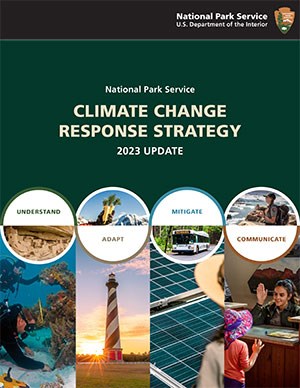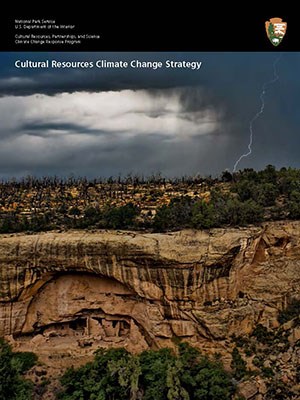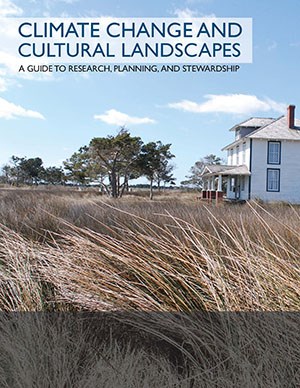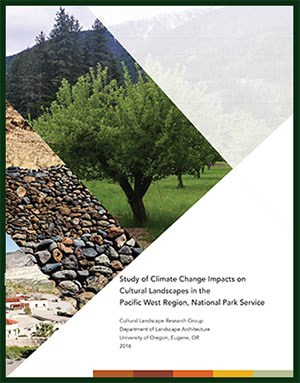Resources, Policy, & Guidance
-
Climate Change and Cultural Landscapes: A Guide to Research, Planning, and Stewardship
-
New Discoveries Uncovered from Melting Glaciers in Wrangell-St. Elias National Park and Preserve
-
Preservation Briefs 39: Holding the Line: Controlling Unwanted Moisture in Historic Buildings
-
Guidelines on Flood Adaptation for Rehabilitating Historic Buildings

NPS Climate Change Response Strategy
The NPS Climate Change Response Strategy (2023 Update) provides a framework for addressing the challenge of climate change across the National Park System, including in cultural landscapes. The goals and actions of the strategy are organized around four integrated cornerstones:-
Understand
-
Adapt
-
Mitigate
-
Communicate
The 2023 update superceded the 2010 National Park Service Climate Change Response Strategy. The accompanying Climate Change Action Plan outlines specific high-priority actions that directly address climate change impacts to NPS units.
NPS Cultural Resources Climate Change Strategy

The 2016 NPS Cultural Resources Climate Change Strategy sets out specific directions for action for stewarding cultural resources in response to climate change and tiers off of the broader NPS Climate Change Response Strategy.
Specific to cultural resources, the 2016 strategy identifies major directions of actions and collaboration for the NPS, including:
-
Goal 1: Connect Impacts and Information
-
Goal 2: Understand the Scope
-
Goal 3: Integrate Practice
-
Goal 4: Learn and Share
Under Goal 3, Intergrate Practice, the NPS Cultural Resources Climate Change Strategy outlines Directions for Action, including:
1) Merge cultural resources with major climate change approaches,
-
sustainability and mitigation
-
disaster risk reduction and response
-
scenario planning
-
climate communication
2) Integrate climate change into ongoing cultural resource management practices in the broad categories of research, planning, and stewardship.

NPS
According to the NPS Climate Change Response Program, climate change response strategy for cultural resources, including cultural landscapes, includes:
-
baseline inventory of cultural resources,
-
conducting vulnerability assessments,
-
monitoring the condition of cultural resources as they are stressed by a changing climate, and
-
identifying appropriate actions for vulnerable resources before the threat from climate change becomes acute.
Please visit the Cultural Resources Climate Change Strategy webpage for more details.
Climate Change and Cultural Landscapes: A Guide to Research, Planning, and Stewardship

Based on the Cultural Resources Climate Change Strategy, a framework for managing cultural landscapes affected by climate change entitled Climate Change and Cultural Landscapes: A Guide to Research, Planning, and Stewardship was published by NPS in 2017 in partnership with the Cultural Landscape Research Group at the University of Oregon.
Cultural landscapes, a combination of both human and natural systems, will be affected in many ways by climate change, and current impacts the potential to be expanded or exacerbated in the future as air temperature rises.
This guide is intended for managers of cultural landscapes to address current and projected climate change impacts, and includes a decision framework that tiers off of the NPS Cultural Resources Climate Change Strategy. The framework is organized broadly around the NPS cultural resources model of research, planning, and stewardship.
Each section of the guide includes an overview of the process, recommended tools and resources, and guiding considerations in addition to specific cultural landscape examples at eight NPS units in the northeastern and western continental United States and Hawaii.
Study of Climate Change Impacts on Cultural Landscapes in the Pacific West Region

The Cultural Landscape Research Group (CLRG) within the College of Design at the University of Oregon, in collaboration with the National Park Service Pacific West Region Cultural Resources Program, has prepared a Study of Climate Change Impacts on Cultural Landscapes in the Pacific West Region of the National Park Service.
The project responds to the growing need to understand the potential effects of projected climate trends and events on cultural resources, with specific emphasis on cultural landscapes. With their historical variability, cultural landscapes of the Pacific West Region will be affected differently by changes in temperature, precipitation, storm frequency, and, in some cases, sea level rise. This study aims to provide a systematic assessment of these changes, and serves as a case-study model for assessment the projected effects of climate change on cultural landscapes.
Included in this study are 164 cultural landscapes in 43 parks within the states of Arizona, California, Hawaii, Idaho, Nevada, Oregon, Washington, and the territory of Guam. Using both NPS and USGS climate data, the CLRG consolidated the historical and projected climate exposure of each of the 164 cultural landscapes. The team then assessed the current condition of six cultural landscapes through site visits, and analyzed the historical climate events and trends that have impacted the sites in the past.
In the second phase of the project, the CLRG assessed the sensitivity of the six case studies to historical and projected climate exposure and identified the sensitivity of the cultural landscape’s character-defining features. This analysis involved on-site workshops with NPS staff including archeologists, biologists, climate scientists, ecologists, fire technicians, historians, landscape architects, and orchardists, among others.
In each case study, the exposure, sensitivity, and adaptive capacity were identified. The NPS Pacific West Region Cultural Resources Program will use this vulnerability assessment to develop recommendations toward the agency's goal of ensuring that cultural landscapes are resilient to climate change and ultimately preparing holistic management strategies for highly vulnerable cultural landscapes.
Both parts of the project can be downloaded from the NPS IRMA website:
Additional Articles
-
Climate Change and Indigenous Peoples: A Synthesis of Current Impacts and Experiences (October 2016)
-
Favorable Climate Change Response Explains Non-Native Species' Success in Thoreau's Woods
-
Frozen in Time: Artifacts Preserved in Ice Reveal a Lost Chapter of Ancient Life
-
What History Gives, The Sea Steals (Elizabeth Preston for Hakai Magazine, January 12, 2016)
Last updated: July 10, 2024
